100 YEARS OF FEMINIST HISTORY EXPLAINED IN 10 WOMEN’S WORK SUITS
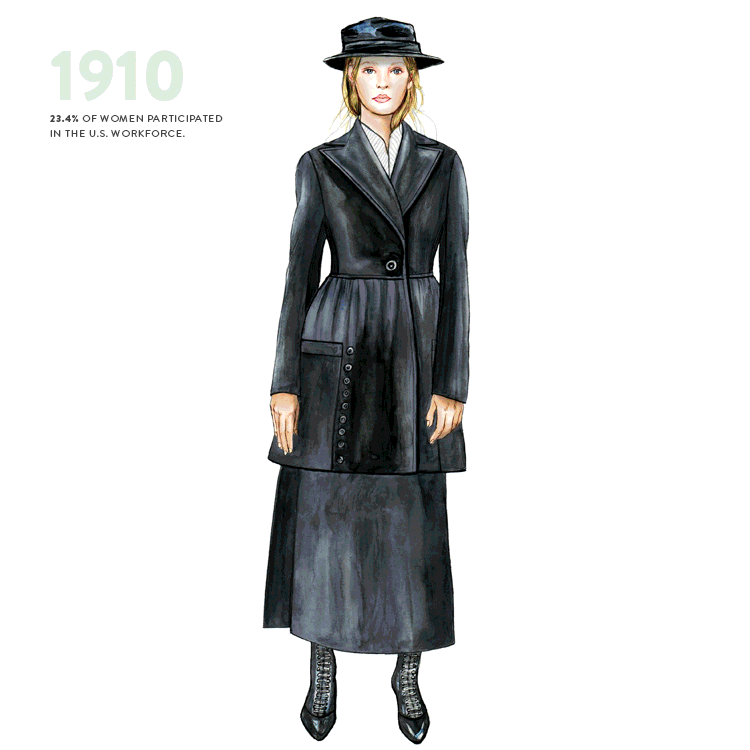
In 2012, Spanx’s Sara Blakely became the youngest self-made female billionaire. In 2013, the Pentagon ended its ban on women in the military serving on the front lines. In 2014, a record 100 women were elected to serve in the 114th Congress. In 2015, Canadian Prime Minister Justin Trudeau ensured that his cabinet had an equal number of women and men “because it’s 2015.” 1 And in 2016, Hillary Clinton became the first-ever female presidential nominee of a major party. The past five years have provided plenty of standout moments for women, but just how far have women really come? MBA@UNC took a trip down memory lane to find out.
The 10 illustrations of women’s work suits below are a testament to the evolution of feminism from 1910 to current day. One hundred years of work to achieve equal rights for women are compressed into 10 images to show how styles have changed over time in response to significant moments throughout the history of feminism. In the past, women were restricted—both in style and rights—but now they do not have to wear a suit jacket to prove their authority. Women have carved out their standing in the world.
1910: 23.4% of women participated in the U.S. workforce
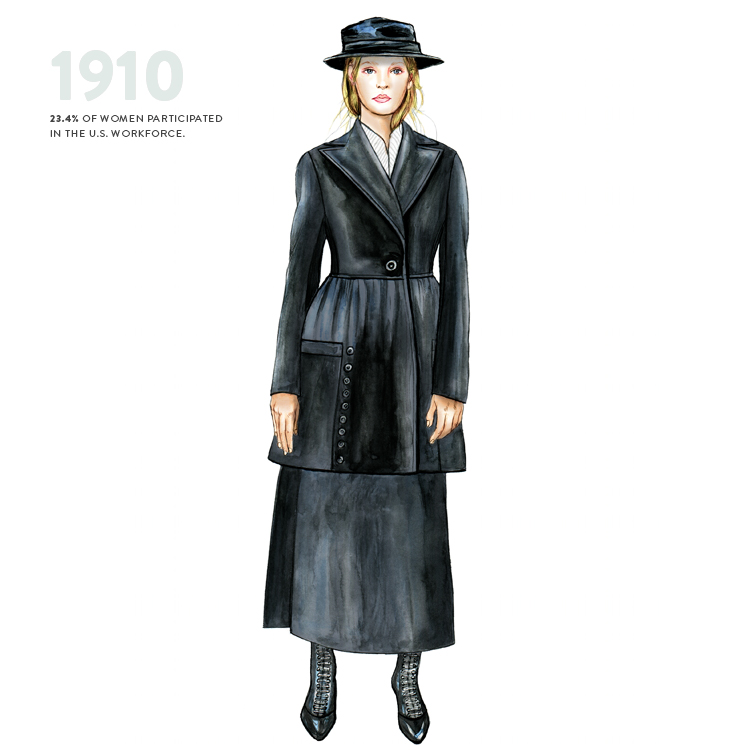
The American Ladies’ Tailors’ Association created the “suffragette suit” in direct response to the hobble skirt, which was hemmed so tight at the ankles that it made it hard for a woman to take unrestricted steps. 2 The hobble skirt was often mocked for contradicting the progress that women were making at the time. Providing women with more freedom to move, the suffragette suit was worn to combat legislation that sought to enforce the mandatory wearing of corsets and a hemline no shorter than one inch off the ground.
1920: 21% of women participated in the U.S. workforce
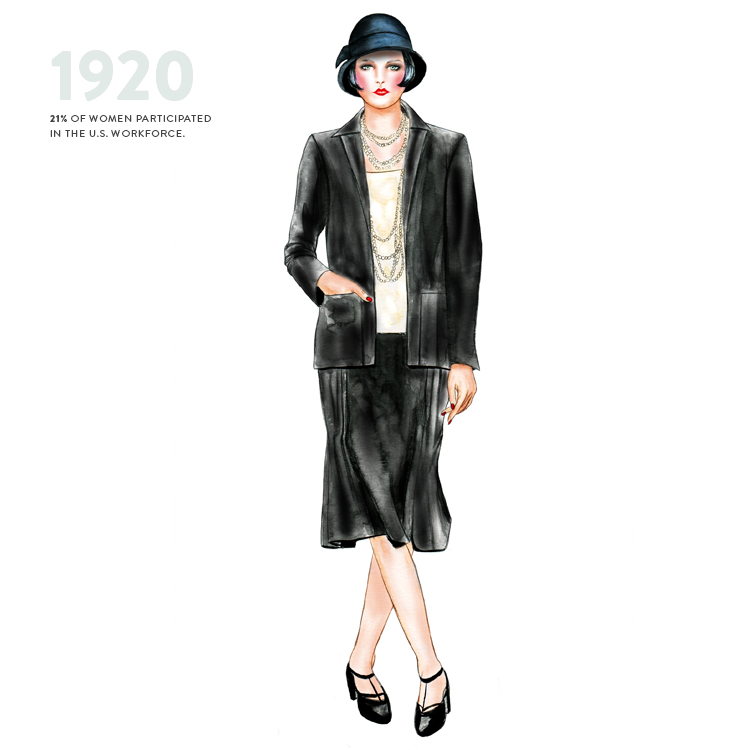
In 1925, Coco Chanel freed women from the corset with her menswear-inspired cardigan style jackets. Women were becoming more active, so Chanel pared down fussy details and used wool for comfort to accomodate their needs. “I gave them real arms, real legs, movements that were authentic and the possibility to laugh and eat without, necessarily, having to faint,” she said. 3 This concept of casual chic was adopted just as the 19th Amendment guaranteeing women the right to vote was ratified.
1930: 22% of women participated in the U.S. workforce
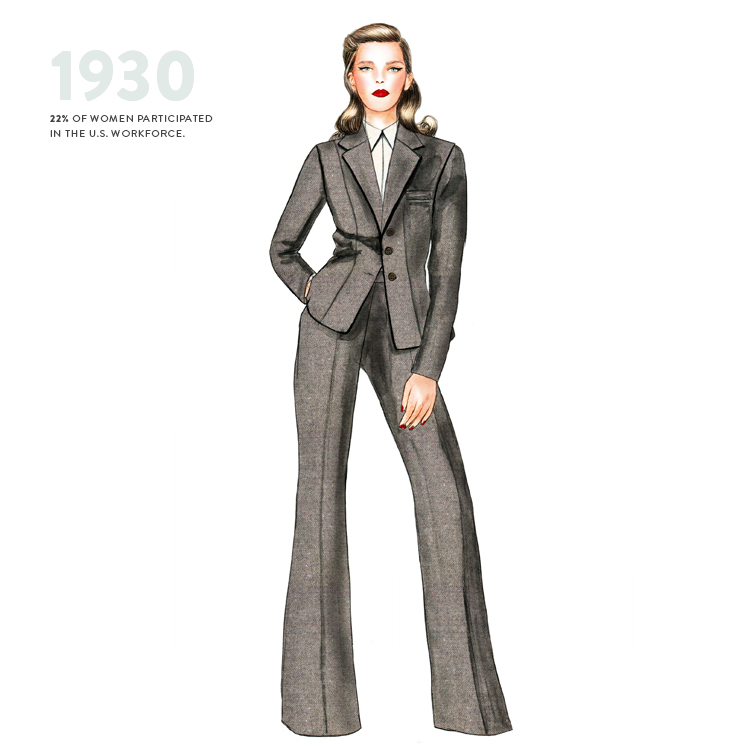
Following Chanel’s lead, French designer Marcel Rochas took women’s desire to wear suits and to wear pants one step further by marrying the two together to create the pantsuit in 1932. The need for a more powerful suit evolved when women entered the workforce in larger numbers—at a rate twice that of men—primarily because employers were willing to hire them at reduced wages. As a result of the low wages of the Great Depression, many working women could not make ends meet to pay basic expenses. They also faced social criticism at this time because they were believed to be taking jobs away from men.
While it has been argued that feminism died during the Depression, women still achieved substantial political gains during the 1930s. The New Deal’s expansion of social welfare services, a field that was dominated by women at the time, led to appointments of women in high government positions. Appointments included many firsts for women: the first Cabinet member, the first director of the United States Mint, the first ambassador and the first judge on the Court of Appeals. 4
1940: 25.4% of women participated in the U.S. workforce
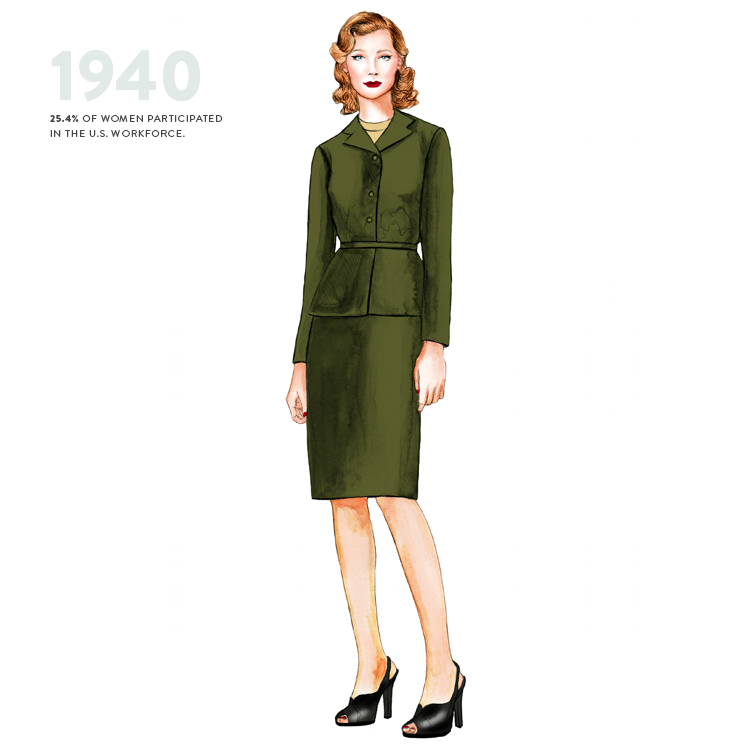
The “wartime silhouette” dominated the 1940s because of fabric rationing. 5 During World War II, uniforms were needed for the military, straining the country’s fabric supply. As a result, clothing made with less fabric became fashionable, and new styles emerged, such as the military look. To reduce waste, items were cut along the lines of the uniforms men were wearing in the same materials and colors. This may be because more women were entering the armed services, too. It was during World War II that the military created women’s branches in each of the armed services. Close to 350,000 women served in the Navy, Army, Coast Guard, Marines and Air Force. 6
1950: 33.9% of women participated in the U.S. workforce
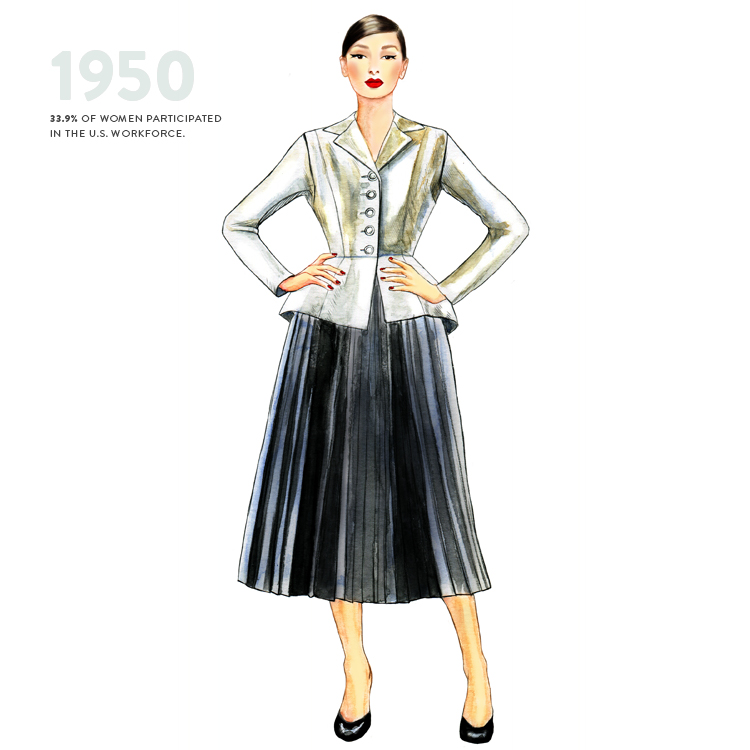
In 1947, Christian Dior introduced the “New Look” with his bar suit, changing fashion history and giving us the modern “fit and flare” style. This ultra-feminine style, developed by Dior to accentuate a woman’s shape, was a reaction to the budget limitations from the war—some of his skirts used 20 yards of fabric. Feminine fashion continued to be created in reaction to the sexless styles of the war years.
The booms of the 1950s had a particularly confining effect on women. Women were being urged to leave the workforce and embrace their roles as wives and mothers. And while the idea that a woman’s most important job was to bear and raise children was hardly a new one, it began to generate dissatisfaction among women who craved a more fulfilling life. This dissatisfaction led to the rebirth of the feminist movement in the 1960s.7
1960: 37.8% of women participated in the U.S. workforce
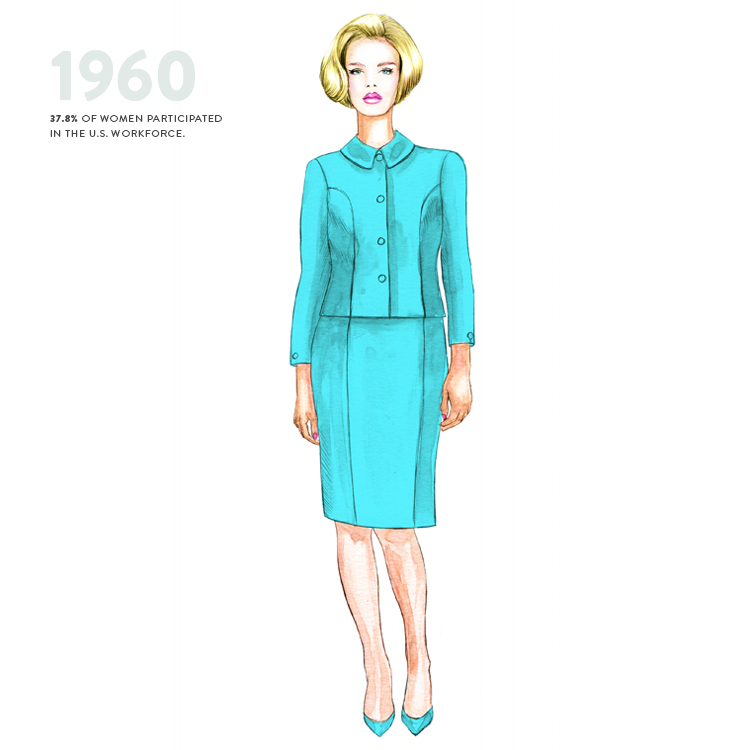
Throughout the 1960s, ensemble dressing was trendy, and suits became more casual. It was the decade of the leg: Minidresses and miniskirts became fashionable for women for the first time. The structured look became androgynous as women’s rights advanced with the Equal Pay Act of 1963, the Civil Rights Act of 1964 and a Presidential Executive Order in 1967 that banned discrimination on the basis of sex in hiring and employment.8 In 1963, Betty Friedan published The Feminine Mystique, which is widely credited with sparking the second wave of feminism in the United States.
1970: 43.4% of women participated in the U.S. workforce
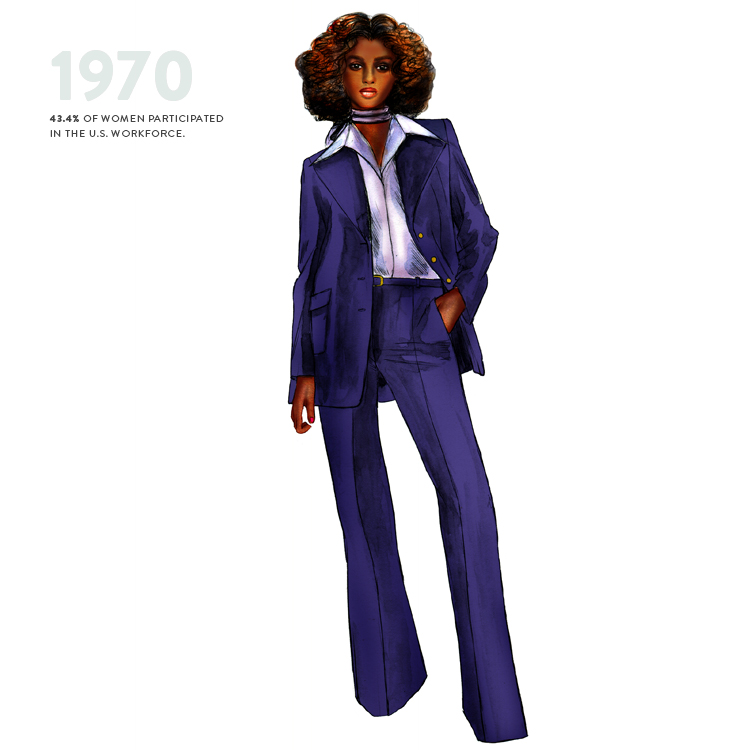
After a decade of peaceful reform movements in the 1960s, the 1970s brought changes in gender roles with women demanding equal rights and advocating for careers outside the home. This led to the formation of the National Organization for Women in 1966 to create an equal partnership with men.
Due to the increase of women working outside of the home, women’s clothing began to change once again. 9 Rather than dress as objects, women opted for unisex clothing. Pantsuits with a masculine edge were popularized as women entered the workforce more than ever before. 10 Pants for women became so mainstream in the 1970s that in 1972, the U.S. government allowed girls to wear pants in public schools under Title IX of the Education Amendments. 11
1980: 51.5% of women participated in the U.S. workforce
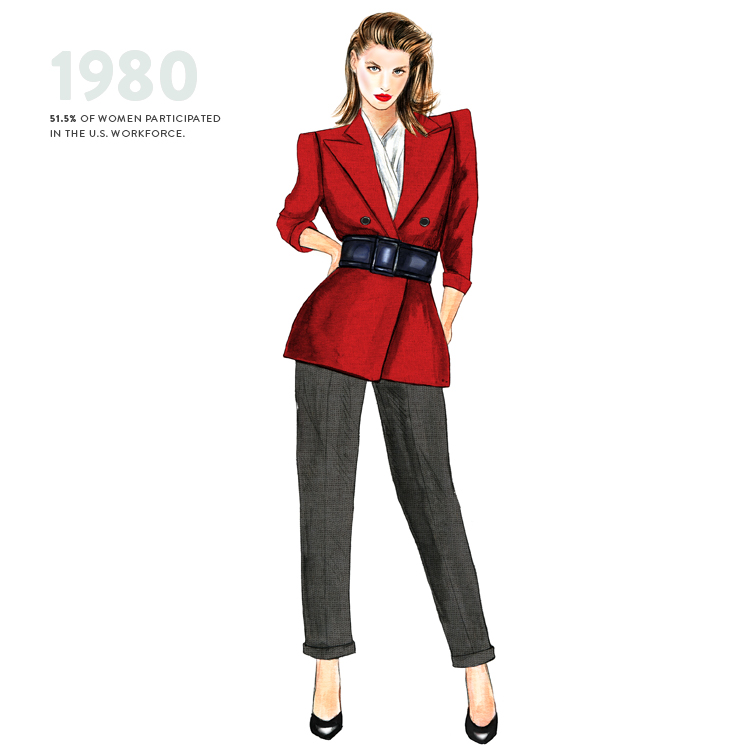
In the decade of the “power woman,” design became all about the menswear-inspired jacket. 12 The trend of the power suit was popular among corporate women and, thanks to TV shows like Dynasty, spread beyond the office walls. The shoulder pads and loose-fitting pants disguised a woman’s figure, taking the focus off her gender and creating a feeling of authority. As a result of the power suit’s popularity, annual sales of women’s suits increased by nearly 6 million—a $600 million gain—from 1980 to 1987. 13 This growth in pantsuits mirrored the growth of women in the workplace as their role in management jobs nearly doubled from 20 to 36 percent. 14
1990: 57.5% of women participated in the U.S. workforce
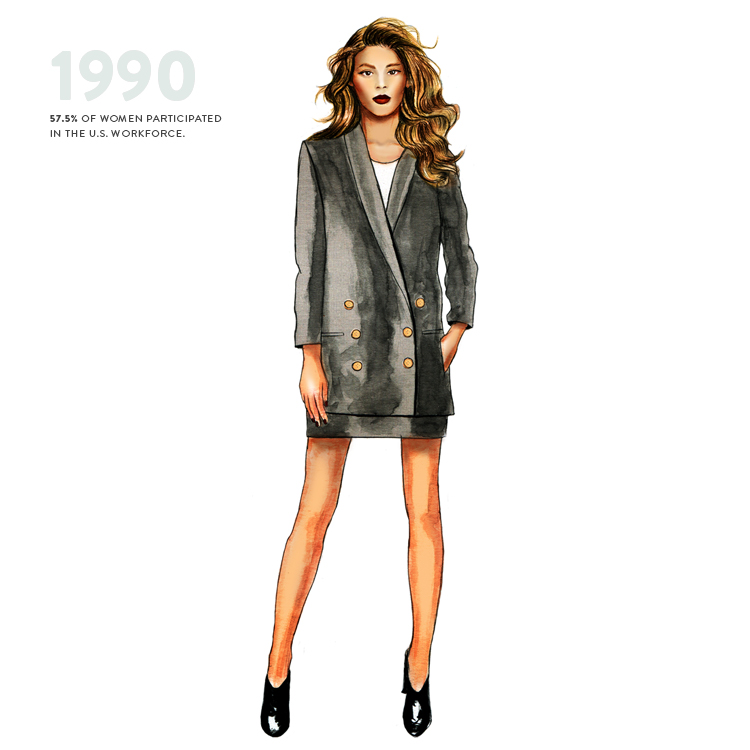
The excess of the 1980s created a fashion hangover that resulted in minimalism—simple cuts in muted palettes of black, cream and beige. Designs put the focus on a woman rather than her clothing. Women’s labor force participation shot up at the end of the 1980s, and as more women took on paying jobs, they gained financial freedom. They could make their own choices and wear whatever they wanted. For example, in 1993 U.S. Senators Barbara Mikulski and Carol Moseley-Braun forced the Senate to lift its ban on women wearing trousers by wearing pantsuits on the Senate floor. 15
2000: 59.5% of women participated in the U.S. workforce
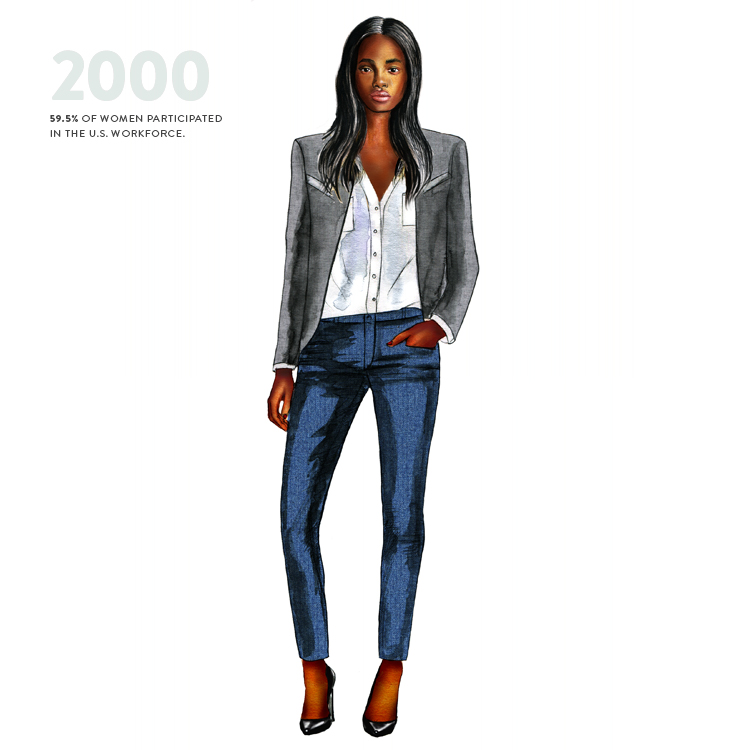
The 2000s have brought about legal changes to attire in the workplace. On December 21, 2015, the NYC Commission on Human Rights announced new guidelines that prohibited “enforcing dress codes, uniforms, and grooming standards that impose different requirements based on sex or gender.” This means that employers may not require men to wear ties unless women are required to wear ties, and women do not have to wear heels unless both sexes have to wear heels.
We are now seeing a move away from the traditional suit in the workplace. Power dressing has reached an age of “anything goes.” 16  With jeans allowed as regularly in the office as blazers, women no longer feel the need to impose their status of power through suits. Women are re-asserting their femininity by wearing dresses and skirts—a new type of power play.
With jeans allowed as regularly in the office as blazers, women no longer feel the need to impose their status of power through suits. Women are re-asserting their femininity by wearing dresses and skirts—a new type of power play.
*Workforce participation numbers for 1910–1970 are from the U.S. Census Bureau’s “Historical Statistics of the United States,” Part D, Page 128. Participation numbers for 1980–2015 are from the U.S. Bureau of Labor Statistics. Numbers represent women ages 16 and older.
*Kristen Fanarakis, founder of luxury apparel line Senza Tempo and an MBA@UNC alum, contributed to this story.
Originally published August 17, 2016
References
1 Canada’s New Prime Minister Says He Picked a Cabinet That’s Half Women ‘Because It’s 2015,’” Slate arrow_upwardReturn to footnote reference
2 The Fascinating History of Women Wearing Suits,” Allure arrow_upwardReturn to footnote reference
3 House of Chanel: Fashion passes style remains,” Chicago Tribune arrow_upwardReturn to footnote reference
4 Working Women in the 1930s,” Judith S. Baughman arrow_upwardReturn to footnote reference
5 World War II and Fashion: The Birth of the New Look,” Lauren Olds arrow_upwardReturn to footnote reference
6 Timeline Special: Women in the United State,” The New York Times Magazine arrow_upwardReturn to footnote reference
7 The 1950s,” History.com arrow_upwardReturn to footnote reference
8 Women’s History in America,” Women’s International Center arrow_upwardReturn to footnote reference
9 Gender in the 1970s: Women’s Fashions,” The History Engine arrow_upwardReturn to footnote reference
10 American Fashion Through the Decades: The Roaring 20s,” InterExchange arrow_upwardReturn to footnote reference
11 Overview of Title IX of the Education Amendments of 1972,” The United States Department of Justice arrow_upwardReturn to footnote reference
12 The Fascinating History of Women Wearing Suit,” Allure arrow_upwardReturn to footnote reference
13 Backlash: The Undeclared War Against American Women,” Susan Faludi arrow_upwardReturn to footnote reference
14 Women in the Work Force,” The Atlantic arrow_upwardReturn to footnote reference
15 When did women begin wearing pants?,” Stuff Mom Never Told You arrow_upwardReturn to footnote reference
16 The Evolution of the Female Power Suit & What It Means,” Bustle arrow_upwardReturn to footnote reference


